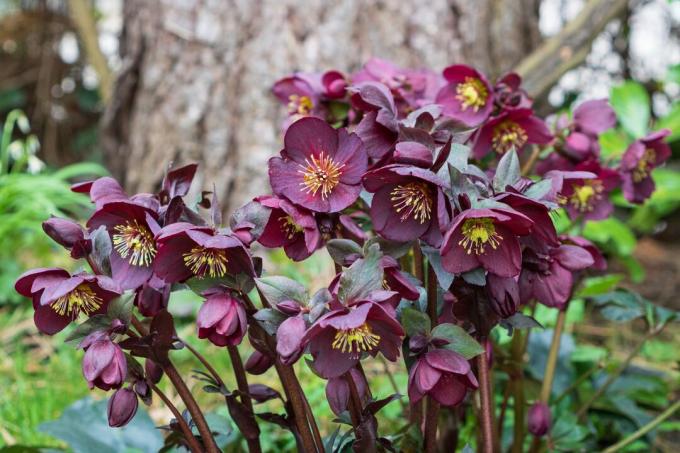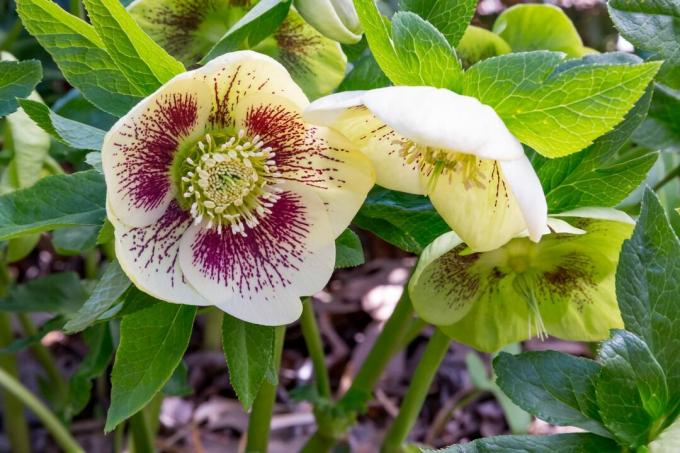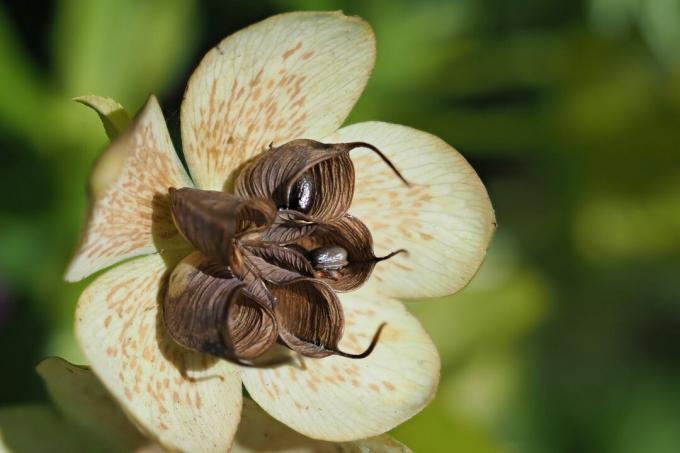Lenten roses are among the plants that open their beautiful blossoms very early in the year and thus bring some color into the monotonous landscape.

The multicolored flowers of the spring rose (Hellebore orientalis). The specimens that can be found in the gardens are mainly hybrids, i.e. crossings of the lenten rose with other species of the genus Helleborus. The lenten rose is also a very uncomplicated, easy-care perennial, that of the related species Christmas rose (Helleborus niger) looks confusingly similar - but they differ in the flowering period.
contents
- Lenten rose: flowering time and properties
- The most beautiful varieties of lentil roses
- Plants: location, timing and procedure
- Care: Cut, water and fertilize spring roses
- Are spring roses hardy?
-
propagate lentil rose
- propagation by division
- Propagation by seed
- Are spring roses poisonous?
Lenten rose: flowering time and properties
Oriental Hellebore and Spring Christmas Rose are synonyms for Lenten Rose. It belongs to the buttercup family (Ranunculaceae). Their homeland is in Turkey and the Caucasus. The perennial, herbaceous perennial can reach a height of between 30 and 40 cm. It grows rather slowly and forms rhizomes with which it can survive well in the local winter.
Important: Lenten rose is a potent poisonous plant.
The leaves of the evergreen lenten rose grow basally and are fingered. Their surface appears leathery and the edge of the leaf is serrated. The color changes from light green to dark after budding. Only when the new leaves have already sprout does the old foliage of the plant die off. Usually five common petals adorn the terminal flowers of the Lenten Rose, but there are also hybrids with double flowers. As far as the flower color is concerned, the spring Christmas rose is very multifaceted due to many years of breeding and can be selected from a large color spectrum. However, when they fade, the color of the flowers turns green. This also enables these parts of the plant to carry out photosynthesis. After fertilization, the follicles of the lenten rose develop. The perennial is also insect-friendly and of particular interest to wild bees, as it blooms at a time when there are few other food sources. However, this only applies to a limited extent to filled varieties.
When does the spring rose bloom? The flowering period of the spring rose usually extends from February to April.

What is the difference between Lenten Rose and Christmas Rose? The lenten rose and the Christmas rose are two different species of the same genus and look very similar. However, they differ in the flowering period, because, as the name suggests, the Christmas rose blooms at Christmas. In addition, the Christmas rose, in contrast to the Lenten rose, has pure white flowers and the demands on the location are also slightly different.
The most beautiful varieties of lentil roses
As already mentioned, garden lentil roses are mainly hybrids. However, there are a lot of them and therefore you have a large selection of beautiful lenten roses with different colored flowers at your disposal.
- Helleborus x hybridus ˈDouble Ellen Whiteˈ: The flowers of this variety are delicately white in color and slightly double. It blooms from January through April. In a good location it will reach a height of about 40 cm and a width of 50 cm.

- Helleborus x hybridus ˈBlue Metallic Ladyˈ: The metallic purplish-blue shimmer of the flowers makes this strain something special. The bee-friendly perennial flowers from February to April and grows to a height of 30 to 40 cm.
- Helleborus x hybridus ˈWhite Spotted Ladyˈ: This variety convinces with its exciting flower colors from February to April. The petals are white in color and patterned with red. The cultivated spring roses from the Lady series are also characterized by excellent growth traits.

Plants: location, timing and procedure
The location for the lenten rose can be sunny to semi-shady. She not only feels at home in the bed, but also in the living area at the edge of the wood, under sparse shrubs and deciduous trees. The perennials prefer fresh, well-drained and humus-rich soil that occasionally dries out a little. Ideally, this should be thoroughly loosened before planting to make it easier for the spring roses to spread their roots deeply. In addition, the soil can be improved with a little lime.
The winter-green perennial is best planted between autumn and spring, as this is when root growth takes place and the plant can develop well in the new location. Keep a planting distance of about 50 cm between individual specimens so that the spring roses can spread undisturbed. They prefer to stand alone or in small groups. If the chosen location does justice to the Lenten Rose, it proves to be very long-lived.
Can the lenten rose be cultivated in a bucket? The spring rose can also be planted in a bucket. What needs to be considered here is the space requirement that the perennial develops over time. The pot should have a diameter of at least 25 to 30 cm and the plant should be rejuvenated by division every two to three years. Use high-quality potting soil as the substrate. Our Plantura organic potting soil already contains the optimal mixture of compost, coconut and wood fibers, expanded clay and coordinated, primarily organic, vegan fertilizer components.
Care: Cut, water and fertilize spring roses
Lenten Rose is particularly at risk of drought in sunny locations. Although it can survive shorter periods of drought, it also shows that it is too dry for it by having fewer flowers. Therefore, the soil should be kept moist by watering during these phases. However, if the substrate is allowed to dry out occasionally, this is beneficial, since constant moisture can cause root rot.
Wilted, brown, or black leaves should be removed before flowering to prevent leaf spot disease from developing or spreading. Furthermore, the infructescence can be removed after flowering to avoid seeding and direct the plant's energy into the leaves and rootstock. The use of the lenten rose as a cut flower should not be ignored. It is cut in a slightly open state and keeps for about a week in a cool place. To extend the shelf life, the water should be changed daily and the stems should be freshly cut. The spring rose in the vase can be combined with other spring flowers such as the daffodils (Narcissus) or hyacinths (Hyacinthus).

For the nutrient supply, it is basically sufficient to support the lenten rose in the spring before flowering with a dose of compost or a high-quality slow-release fertilizer like ours Plantura organic flower fertilizerright to use. This strengthens your plants with a balanced nutrient composition and ensures the high organic content for soil care, which is very beneficial to the health of the lenten rose in the long run is. Some lime can be applied to lime-poor soils in autumn.
Are spring roses hardy?
Lenten roses are basically hardy because they are classified in winter hardiness zone Z6 and can therefore withstand temperatures down to around -23 °C. However, there is no harm in protecting younger plants with a layer of leaves or brushwood. If the perennial is cultivated in a bucket, it should definitely be wrapped in fleece or foil and placed on a styrofoam plate, for example. Don't forget to give your Lenten Rose some water on frost-free days, even in winter.

propagate lentil rose
The lenten rose can be propagated well by division and sowing. To do this, proceed as follows.
propagation by division
The plant can be divided in autumn or in spring after flowering. To do this, the rhizomes of the perennial are dug up and cut into several pieces with a sharp knife or spade. Young plants can often be easily divided without tools. Make sure that there are enough leaves, buds and roots on the individual parts. Now the sections can be buried again and thoroughly watered. If the division takes place in autumn, the plants should receive winter protection from leaves or fir branches. Well-rooted sections usually bloom the next year.
Propagation by seed
Basically, you can leave the propagation by sowing the lenten rose yourself or you can take it into your own hands. However, the first bloom only appears after two to three years. For propagation, the ripe seeds are removed from the dried fruit heads. The seeds are either sown directly outdoors or in pots and only lightly cover them with soil. It can take a long time before the first germs appear. The substrate should always be kept moist, but not wet. The pots with the young plants should also remain outside in winter, but in a sheltered and covered location. The exposure to cold is necessary for germination.

Tip: The perennials tend to cross species - so if you have planted different Helleborus species in the garden, be curious about the result when propagating by seed.
Are spring roses poisonous?
All parts of the lenten rose are classified as highly toxic for humans and animals due to the saponins they contain and the glycosides helleborein and hellebrin. Helleborein is one of the cardioactive glycosides, which can lead to an increase in heart rate and a reduction in heart rate. Most of the substances are contained in the rootstock. After eating a part of the plant, symptoms of poisoning such as nausea, dizziness, diarrhea, but also cardiac arrhythmias can occur. In the worst case, consumption can even lead to death. The sap can also cause skin irritation and the smell of the perennial makes some people sneeze.
According to your location preferences, the Oriental Hellebore fits perfectly in one forest garden. You can read about what forest gardens are all about and which plants are also suitable for them in our special article.



